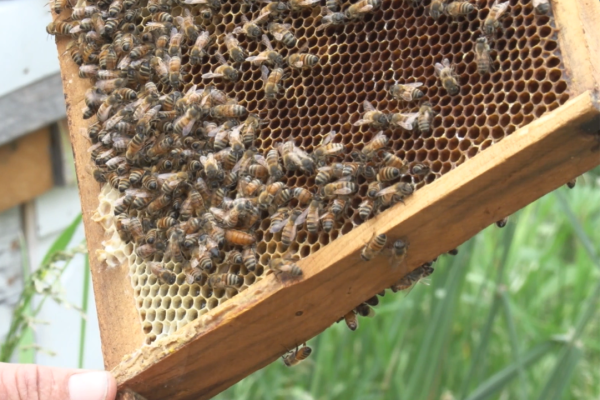BRIDGEPORT, N.Y. (NCC News) — Honey bees are a vital part of the ecosystem. Their work pollinating our plants ensures that people have food on their tables and air to breathe.
Despite being so important to our daily lives, those with bee sting allergies have to be very cautious once the summer months roll around.
Local beekeeper and founder of It’s All Better Honey Bee Rescue Bill Kaufman says this time of year, the earliest weeks of summer weather, are when the bees really start to come out.
“The first week of June is always prime swarm season, so bees show up everywhere,” Kaufman said. “Of course, people are getting outside in the nice weather, so they’re noticing the bees.”
Kaufman said that he’s been getting an influx of calls lately related to hives people are finding on their properties. He says the bulk of what he does daily is rescuing honey bee colonies and bringing them back to his property. He has several colonies living in hives contained in boxes on his property.
Bee sting allergies tend to be severe, inducing the most severe of allergic reactions.
“It can make the airway swell, tongue swollen, lips swollen, and it can kill a person. That’s called anaphylaxis,” Dr. David T. OuYang said. OuYang is a family medicine physician, and has done ENT (ear, nose and throat) work in the past. He added that anaphylaxis can actually kill a person.
But what exactly is an allergy? It’s when the immune system attacks a foreign particle it sees as a threat, even if it isn’t actually dangerous to us.

According to the CDC, about 62 people each year die from bee stings. In the event that someone with an allergy does get stung, OuYang says that preparation is important.
“It’s all about preparation, preparation, preparation. That’s what we say,” OuYang said. “If they know that they’re an anaphylactic patient, we definitely want them to have their EpiPen.”
EpiPen stands for epinephrine auto-injector. People can get EpiPens prescribed to them through their physicians. OuYang gives his patients several refills, which he encourages them to fill as quickly as possible.
Then, with those refills, OuYang advises his patients to keep an EpiPen in various locations, such as their bedroom, their kitchen, their car, etc. That way, someone with a life-threatening allergy can be prepared for a sting in any location.
The best way to not get stung, though, is to let the bees be. Kaufman says that poking and prodding bees can irritate them, along with getting too close to their hives.
“They don’t want to sting, they really don’t, especially honey bees,” Kaufman said. “It’s the last thing they’ll ever do. As soon as they sting, their stinger pulls out, along with part of their sting gland, and so they die.”
Wasps and hornets are a different story, though. They can sting multiple times. Therefore, there won’t be a stinger to pull out of the irritated sting site.
For honey bee stings, Kaufman recommends using a credit card or something thin and flat to scrape the stinger out of the sting site. Honey bee stingers are barbed, so they lodge into the skin, and the sting gland pumps venom for about two to three hours.
He says the sooner you can get the stinger out, the better.
OuYang explained that educating young kids with bee sting allergies about what to do to avoid a sting is essential. He says one of the most important things for them to know about are ground bees, meaning bees that make their nests in the ground.
Kaufman says that sometimes, you don’t know you’re on a ground bee nest until you see the bees get angry. However, even these bees don’t want to sting. If you leave any kind of stinging bee alone, they won’t be inclined to sting you, as stinging is their defense against threats, according to Kaufman.
If you have a bee sting allergy and get stung, administer an EpiPen as soon as possible. Then, call 911 and keep track of how many EpiPen doses the patient has received; you can administer an EpiPen every 10 to 15 minutes.




